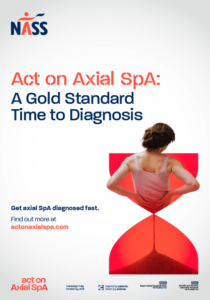Home > Building Public Awareness
Signpost your newly diagnosed patients to our new self-management programme Your SpAce

Axial SpA is an inflammatory disease of the spine and joints. Inflammation where muscles attach to the bones causes extreme pain. If left untreated, it can permanently fuse bones together. It’s an invisible and misdiagnosed condition. Often leaving people feeling powerless, in increasing pain and extreme exhaustion.
Right now, it takes an average of 8.5 years for someone to receive a diagnosis of axial SpA. In June 2021, we launched our implementation plan Act on Axial SpA: A Gold Standard Time to Diagnosis, which outlines the steps we are taking to establish a Gold Standard time to diagnosis of just one year. Read the full plan here.
In 2021, our research found that 91% of the UK population had never heard of axial SpA, 8 in 10 people could not identify the symptoms and only 4 in 10 would speak to their GP if they had symptoms. It was clear from these results that raising public awareness around the signs and symptoms of axial SpA would be a crucial piece of the puzzle when working to reduce the time from symptom onset to diagnosis.
There are lots of ways you can help.
We have created posters, videos and other resources you can print out and use to increase awareness in your community. Access everything you need here:
We worked with members of our community and comedians to shed light on the realities of life with axial SpA. These videos use humour to explain the issues of delayed diagnosis and ongoing, undiagnosed symptoms of axial SpA.
Use these videos as a light-hearted way to explain two major issues in axial SpA diagnosis and care:
Together, with healthcare professionals, we are going to drive down diagnosis times and catalyse improvements in axial SpA care.
Dr Antoni Chan, rheumatologist at Royal Berkshire Hospital, joined NASS CEO Dr Dale Webb to discuss the problems being faced by healthcare professionals and the work NASS is doing to influence change and support improvements in axial SpA services.
Why not use this video in your presentation to inspire colleagues?
Send your patients straight to our axial SpA symptom checker by requesting a QR code to put on your posters.
The symptom checker was created using validated criteria*.
It walks patients through a series of questions before determining whether they may have axial SpA. If the results are positive, patients will be provided with a printable information leaflet to take to their GP.

Request a QR code by emailing: commsteam@nass.co.uk
* 1. Sieper J, van der Heijde D, Landewe R, Brandt J, Burgos-Vagas R, Collantes-Estevez E, et al. New criteria for inflammatory back pain in patients with chronic back pain: a real patient exercise by experts from the Assessment of SpondyloArthritis international Society (ASAS). Annals of the rheumatic diseases. 2009;68(6):784-8.
2. Rudwaleit M, Metter A, Listing J, Sieper J, Braun J. Inflammatory back pain in ankylosing spondylitis: a reassessment of the clinical history for application as classification and diagnostic criteria. Arthritis Rheum. 2006;54(2):569-78.
3. Calin A, Porta J, Fries JF, Schurman DJ. Clinical history as a screening test for ankylosing spondylitis. JAMA. 1977;237(24):2613-4.
We’d love to know if these resources were helpful, or if there are any other promotional materials that you would find useful.
Let us know!
Send your feedback to: commsteam@nass.co.uk
For information, advice and to join a community of people who live with the condition visit the NASS website. Or visit our helpline.
Copyright ©2021 NASS. All Rights Reserved. NASS is a registered charity in England and Wales (1183175) and Scotland (SC049746)
Site by GIANT and Quickfire Digital
This website uses cookies so that we can provide you with the best user experience possible. Cookie information is stored in your browser and performs functions such as recognising you when you return to our website and helping our team to understand which sections of the website you find most interesting and useful.
Strictly Necessary Cookie should be enabled at all times so that we can save your preferences for cookie settings.
If you disable this cookie, we will not be able to save your preferences. This means that every time you visit this website you will need to enable or disable cookies again.